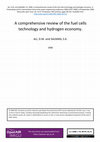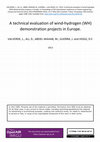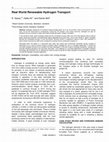Papers by Dalia Morsi Ali

The degrading of the air quality resulting from the emissions of the existing energy conversion d... more The degrading of the air quality resulting from the emissions of the existing energy conversion devices, in addition to the recent instability of the oil prices forced the need to a more stable zero-emission distribution generation technology or combination of technologies which allows a clean, cost effective supply of energy, on demand on a large scale and in any location. Thus, renewable energy generation or the decentralized power systems like wind, photovoltaic, as well as new hydrogen and fuel cells technologies are developing nowadays to take over from fossil hydrocarbons combustion. Fuel cell is an emerging technology which could allow a clean, cost effective supply of energy on demand on a large scale and in any location. This paper will act as a literature survey to the fuel cell technology. It will introduce the different fuel cell types with their advantages and disadvantages, and their suitability for different applications. It will also discuss the technical and economic issues facing the spread of this technology, and how to move to a worldwide hydrogen technology. It will also brief the current state of fuel cells with both drivers and barriers to its market growth. Further recommended work for the advance and spread of use of the fuel cells will be also highlighted.

4th International Conference on Power Engineering, Energy and Electrical Drives, 2013
Investment in Renewable (RES) is at the center of energy policy i shortcoming of renewable energy... more Investment in Renewable (RES) is at the center of energy policy i shortcoming of renewable energy is intermittency which can pose a risk to energy supply. Energy storage thus beco order to address the mismatch between en supply. The utilization of Wind-Hydrog storage systems and Fuel Cells provides This paper presents a technical evalu Hydrogen (WH) Demonstration projects scope of evaluation includes a compara design criteria, operation and energy man with technical challenges. It is argued Hydrogen and Fuel cell Energy system efficient electrolyzers and better ener systems and that lab-scale testing is esse inform the development of future demonst Keywords-renewable; hydogen energy techn demonstration projects; electrolysis, fuel cell; pe I. INTRODUCTION The energy industry is facing a tra Traditional coal-fired power plants are bei some countries due to environmental regula Directive 2008/50/EC on ambient air quality National Ambient Air Quality Standards in Such regulations are driving investment to Energy Sources (RES), distributed genera Grids. The European Union (EU) has th specific objectives: security in the ene reduction of emissions and providing the re with competitive support [2]. The direc promotes and supports the use of RES in Eu the EU countries have adopted policies to s RES which is evident by the increase of up energy since 2004 (Figure 1). The share renewable sources in gross final energy co luation of Wind-Hyd ration projects in Eur
IET Conference on Reliability of Transmission and Distribution Networks (RTDN 2011)
ABSTRACT

Environmental challenges include water and energy consumption. The rapid growth in population ass... more Environmental challenges include water and energy consumption. The rapid growth in population associated with industrial and agricultural expansion, especially in industrial countries, have resulted into a higher per capita water consumption and global warming making the need for viable and environmentally friendly solutions to become essential. However, producing good quality water combined with minimum energy usage has proven to be a challenging field for researchers. The increasing need for convenient water resources for the agricultural, industrial and public water users might lead to higher water prices, constricted economic development and social problems in regions with limited water access. As a result, the general welfare of a country like Qatar under water stress conditions is threatened. The motivation behind this work arises from the world’s rising needs for water while preserving the environment for the well-being of future generations. This study focus on Qatar, displa...

Energy Storage Devices [Working Title]
The dominating trend of variable renewable energy sources (RES) continues to underpin the early r... more The dominating trend of variable renewable energy sources (RES) continues to underpin the early retirement of baseload power generating sources such as coal, nuclear, and natural gas steam generators; however, the need to maintain system reliability remains the challenge. Implementing energy storage with conventional power plants provides a method for load leveling, peak shaving, and time shifting allowing power quality improvement and reduction in grid energy management issues, implementing energy storage with RES smooth their intermittency, by storing the surplus in their generation for later use during their shortfall, thus enabling their high penetration into the electricity grid. Energy storage technologies (EST) can be classified according to many criteria like their application (permanent or portable), capacity, storage duration (short or long), and size (weight and volume). EST suited for short duration storage and low-to-medium power outputs are seen performing better in improving power quality, while those providing medium-to-high power outputs with long durations are seen better suited for energy management of electrical networks. With the growing deployment of renewable energy systems, EST must be utilized to allow the grid to absorb the increased integration of RES generation. The recent advances in hydrogen energy storage technologies (HEST) have unlocked their potential for use with constrained renewable generation. HEST combines hydrogen production, storage, and end use technologies with the renewable generation either in a directly connected configuration or in an indirectly connected configuration via the existing power network. This chapter introduces the hydrogen energy storage technology and its implementation in conjunction with renewable energy sources. The efficiency of renewable hydrogen energy storage systems (RHESS) will be explored with a techno-economic assessment. A levelized cost (LC) model that identifies the financial competitiveness of HEST in different application scenarios is given, where five scenarios are investigated to demonstrate the most financially competitive configuration. To address the absence of a commercial software tool that can quickly size an energy system incorporating HEST while using limited data, a deterministic modeling approach that enables a quick initial sizing of hybrid renewable hydrogen energy systems (HRHES) is given in this chapter. This modeling approach can achieve the initial sizing of a HRHES using only two input data, namely the available renewable energy resource and the load profile. A modeling of the effect of the electrolyzer thermal transients at start-up, when operated in conjunction with an intermittent renewable generation, on the quantity of hydrogen produced is also given in this chapter. Keywords: hydrogen energy storage technology, renewable hydrogen energy storage systems, levelized cost modeling, sizing hybrid renewable hydrogen energy system for a specified demand and renewable resource, modeling the effect of the electrolyzer thermal transients at start-up when powered by renewables on the quantity of hydrogen produced

Qatar Foundation Annual Research Conference Proceedings Volume 2016 Issue 1
The implementation of large-scale renewable energy systems (such as solar and wind) in the GCC is... more The implementation of large-scale renewable energy systems (such as solar and wind) in the GCC is widely growing nowadays, particularly in remote areas generation applications where the grid extension is costly. The integration of renewable energy systems into the existing power grids, especially the hybrid ones like hybrid solar wind systems, not only provide a clean environmentally friendly supply of electricity but also provide a more reliable supply of electricity through the utilization of different energy sources. However, the operating characteristics of such renewable energy systems are strongly influenced by the weather patterns, i.e. intermittent generation, and will therefore impact the operation of the power grid into which they are integrated. Certain amounts of renewable distributed generation can be integrated into the existing grid without affecting its operation; however, the massive introduction of large-scale renewable energy systems into the grid will result into an increased level of risk of overload and over voltage, unacceptable levels of power quality and reliability, together with the possibility of incorrect operation of the protection system. Therefore, significant investments will be needed to enable the existing power grids to accommodate such a large scale of renewable energy systems into it while avoiding such impacts.In this paper, a comprehensive study of the impact of integrating large-scale hybrid renewable energy systems into Qatar's electrical power grid is carried out. The study includes investigating the grid power flow, power quality, efficiency, transient stability, and reliability under both normal and contingency operating conditions. The study aims to give solutions for allowing the increase in large scale hybrid renewable energy systems penetration into Qatar's grid while reducing their influence and maintaining the grid reliability and stability during all operating conditions. The study is performed based on Qatar's grid real-time operating conditions, and takes into account Qatar's climate profile (e.g. Qatar average annual wind speed and solar irradiation) in order to simulate the intermittent output of the integrated hybrid renewable energy system. Moreover, an economic study and an environmental impact study are carried out to evaluate the large-scale integration of hybrid renewable energy systems into Qatar's grid from different aspects. In summary, the carried out studies will show the impact of implementing large-scale hybrid renewable energy systems on the performance of Qatar's power grid, together with its environmental and economic benefits. The real-time implementation will suggest how to introduce the large scale hybrid renewable energy systems gradually into Qatar's grid, and will propose the best scenario for operating both the existing conventional stations and the integrated hybrid systems while balancing their electricity generation with the demand. The real-time implementation utilizes a new smart control and management mechanism that is proposed to allow such a balance between the generation and demand on introducing large-scale hybrid renewable energy systems into Qatar's existing power grid. The outcome of this study will help Qatar in assessing and evaluating the operational, environmental and economic aspects of large scale hybrid renewable energy systems penetration into Qatar's power grid, and will demonstrate the challenges that will face Qatar when integrating such a large capacity into its grid.

Renewable and Sustainable Energy Reviews, 2016
Abstract This paper proposes a thermally compensated electrolyser model coupled with a Pressurise... more Abstract This paper proposes a thermally compensated electrolyser model coupled with a Pressurised Hydrogen Storage model for modelling Renewable Hydrogen Energy Storage Systems needed to support the uptake of renewable energy sources (RES) integration into the grid. The model accurately simulates the output of real world electrolyser and hydrogen storage installations and can be used as a tool for assessing their integrity with intermittent RES. The model, which has been developed using Matlab/Simulink, incorporates a set of thermally compensated simulation equations to emulate the real world operating installations and define their hydrogen production under different energy configurations (grid connected or directly connected to the RES). It can also be used to determine the efficiency of an electrolyser under cold start or during full temperature operation. The proposed model has proved its ability to emulate real world hydrogen energy systems, and this has been validated by comparing its output to the real-world data logged from an existing field installation. The developed model has also been used as a tool to assess the performance of an operating real world system, installed in Africa, and which has not been performing as anticipated. Simulation results revealed the presence of a hydrogen leak within this infield installation, and this has been confirmed by an onsite inspection. The developed model has therefore also proved to be able to examine the performance of operating real-world hydrogen energy systems and detect irregularities and operation performance issues. In summary, this paper proposes a Hydrogen Energy Storage system (HES) model as an enabler simulation tool to support the projected increase of renewable integration into the grid. The model also allows the detection of performance issues within operating HES systems and allows the identification of leaks without the need for conducting intrusive inspections of the installations, hence saving money and time.

Journal of Technology Innovations in Renewable Energy, 2012
Hydrogen represents an excellent energy storage option as it can act as both a short and long ter... more Hydrogen represents an excellent energy storage option as it can act as both a short and long term energy store. As the UK Government is strategically moving the UK towards a low carbon economy, hydrogen can play an important role as a solution to make use of grid constrained 'green' energy in transport. In the transport sector, green hydrogen produced from renewable sources offers one of the best opportunities to reduce green house gas emissions and significantly reduce dependence on fossil fuels. Use of zero carbon or 'green' hydrogen derived from renewable sources in Fuel Cell Electric Vehicles (FCEV) is expected to lead to a 90% 95% reduction in well to wheel emissions by 2020 when compared to existing internal combustion engines [1]. Described within this paper is a real-world case study that utilises grid constrained renewable energy (instead of discarding it) as a source of clean energy to produce 'green' hydrogen for use in a transport application. A model that simulates hydrogen demand from transport has been developed. A Simulink model of hydrogen production, storage and cascade refuelling operations has also been presented. The modelling of a real world application of hydrogen transport technology demonstrates how an electrolyser could be sized to provide the daily hydrogen fuel demand for a real-world commercial hydrogen transport application.
Proceedings of the 41st International Universities Power Engineering Conference, 2006
Noticing the rise in the electricity prices, worrying about the CO2 emissions and global warming ... more Noticing the rise in the electricity prices, worrying about the CO2 emissions and global warming and not sure about living with nuclear power stations, makes everyone think from where energy will come in the coming years. What is needed is a zero-emission distribution generation technology or combination of technologies that allows clean, cost effective supply of energy, on demand on
2011 Asia-Pacific Power and Energy Engineering Conference, 2011
ABSTRACT
2008 12th International Middle-East Power System Conference, 2008
The ever increasing demand for electrical energy and the rise in the electricity prices due to th... more The ever increasing demand for electrical energy and the rise in the electricity prices due to the recent instability of the oil prices in addition to the degrading of the air quality resulting from the emissions of the existing energy conversion devices has intensified research into alternative renewable sources of electrical energy. In this paper a dynamic electrochemical model is

2008 12th International Middle-East Power System Conference, 2008
Reliability assessment techniques and programs handling is an important issue for both power syst... more Reliability assessment techniques and programs handling is an important issue for both power systems planning and testing in existing power system configurations. The Assessment techniques are suitable for detecting weak points in the reliability assessment. The reliability study of bulk power systems indicates the ability of the composite generation and transmission system to satisfy the load demand at major load points. The major burden of the developed methods used is the computation time required to solve a large number of credible contingencies or outage states. This paper presents a novel approach capable of the reliability evaluation for real large-size networks using normal size computers. It calculates the reliability indices at individual load buses and reliability of the whole system. The effect of the loading factor between loads on reliability is also investigated. The proposed approach is expanded to calculate the reliability of composite generation and transmission system taking the following constraints into consideration: amount of reliability of system generation, amount of reliability of transmission lines, maximum system generation capacity, maximum transmission lines capacity and maximum connected load at each bus. The approach is based on the minimal path set and dual fault tree techniques. A new concept of "constant reliability region", which is utilized in the field of optimum operation of power networks, is introduced. A special program is developed for the proposed technique. The comparison between the proposed and the previous techniques confirms that the proposed method is more accurate and precise.
International Universities Power Engineering Conference, 2006
Noticing the rise in the electricity prices, worrying about the CO2 emissions and global warming ... more Noticing the rise in the electricity prices, worrying about the CO2 emissions and global warming and not sure about living with nuclear power stations, makes everyone think from where energy will come in the coming years. What is needed is a zero-emission distribution generation technology or combination of technologies that allows clean, cost effective supply of energy, on demand on

Reliability assessment techniques and programs handling is an important issue for both power syst... more Reliability assessment techniques and programs handling is an important issue for both power systems planning and testing in existing power system configurations. The Assessment techniques are suitable for detecting weak points in the reliability assessment. The reliability study of bulk power systems indicates the ability of the composite generation and transmission system to satisfy the load demand at major load points. The major burden of the developed methods used is the computation time required to solve a large number of credible contingencies or outage states. This paper presents a novel approach capable of the reliability evaluation for real large-size networks using normal size computers. It calculates the reliability indices at individual load buses and reliability of the whole system. The effect of the loading factor between loads on reliability is also investigated. The proposed approach is expanded to calculate the reliability of composite generation and transmission sy...

International Journal of Green Energy, 2013
Energy efficient buildings can reduce the human-impact on the environment. Energy efficiency is n... more Energy efficient buildings can reduce the human-impact on the environment. Energy efficiency is not only concerned with generating more energy using fewer resources, nor reducing energy usage, but also it is about harnessing natural resources, such as wind and sun, to produce energy. The UK government is thus promoting the adoption of renewable energy in buildings. Fuel-Cell Energy Systems (FCESs) which utilises hydrogen from renewable sources (green hydrogen) is a prominent technology yet with little application in the UK built environment. FCESs can help in addressing the problem of intermittent supplies of renewable energy by allowing for energy storage which could act as a buffer to meet the variability in user-demand thereby maintaining energy security. Thus, the aim of this paper is to explore the application of FCES in the UK Built Environment, by drawing on the scant literature as well as discussion with industry experts. With the recent implementation of FCESs in Scotland, the development of guidelines for evaluation of the FCES is timely. A conceptual framework for the evaluation of FCES is thus outlined in this paper which could be piloted in Scotland (and possibly elsewhere). It is argued that such framework provides a holistic and structured approach for establishing the efficacy of FCES which is crucial for informing its wider adoption in the future and in particular when it comes to the Return-on-Investment (ROI) especially from the perspective of funders and the local community.

Energy efficient buildings can reduce the human-impact on the environment. Energy efficiency is n... more Energy efficient buildings can reduce the human-impact on the environment. Energy efficiency is not only concerned with generating more energy using fewer resources, nor reducing energy usage, but also it is about harnessing natural resources, such as wind and sun, to produce energy. The UK government is thus promoting the adoption of renewable energy in buildings. Fuel-Cell Energy Systems (FCESs) which utilises hydrogen from renewable sources (green hydrogen) is a prominent technology yet with little application in the UK built environment. FCESs can help in addressing the problem of intermittent supplies of renewable energy by allowing for energy storage which could act as a buffer to meet the variability in user-demand thereby maintaining energy security. Thus, the aim of this paper is to explore the application of FCES in the UK Built Environment, by drawing on the scant literature as well as discussion with industry experts. With the recent implementation of FCESs in Scotland, the development of guidelines for evaluation of the FCES is timely. A conceptual framework for the evaluation of FCES is thus outlined in this paper which could be piloted in Scotland (and possibly elsewhere). It is argued that such framework provides a holistic and structured approach for establishing the efficacy of FCES which is crucial for informing its wider adoption in the future and in particular when it comes to the Return-on-Investment (ROI) especially from the perspective of funders and the local community.
The ever increasing demand for electrical energy and the rise in the electricity prices due to th... more The ever increasing demand for electrical energy and the rise in the electricity prices due to the recent instability of the oil prices in addition to the degrading of the air quality resulting from the emissions of the existing energy conversion devices has intensified research into alternative renewable sources of electrical energy. In this paper a dynamic electrochemical model is
Renewable and Sustainable Energy Reviews, 2016
The “Hydrogen Office building (HO)” presents a wind–hydrogen energy system, located in Fife/Scotl... more The “Hydrogen Office building (HO)” presents a wind–hydrogen energy system, located in Fife/Scotland, which has been set-up to demonstrate the role of hydrogen in reducing the impact of wind intermittency in a grid-tied microgrid. The main components of the system are a wind turbine, alkaline electrolyser, hydrogen storage and a PEM fuel cell. The building demand is met by the wind turbine, while the fuel cell provides back-up power to the ground floor when wind power is unable to meet the demand.











Uploads
Papers by Dalia Morsi Ali